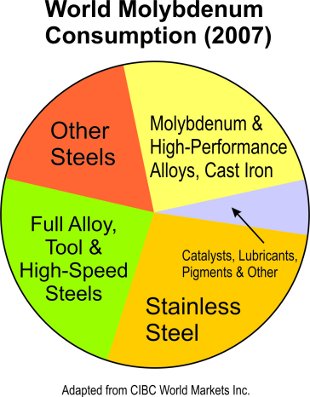Molybdenite (MoS2) is the principal ore of molybdenum (Mo) which spurred much debate among early metallurgists. Some confused the very soft, silvery grey mineral with the similarly soft mineral, graphite. Others insisted it was lead ore and named it molybdos, meaning lead-like. Not until 1778 did the Swedish chemist extraordinaire, Karl Scheele, identify molybdenum as a new element.
Molybdenite is generally found within igneous rocks such as granites, particularly where they have intruded and reacted with sedimentary rocks. It is typically associated with other sulphide minerals, notably copper. About 60% of the world's molybdenum output is a byproduct of copper mining.
Main Uses. Molybdenum is remarkably versatile. It can withstand extreme heat with little expansion or softening, yet it is soft enough to scratch with a fingernail. It has high thermal conductivity, but its density is about half that of tungsten.
Such versatility gives molybdenum a major role in many industrial applications. As a metal alloy, 'moly' boosts toughness and heat resistance in steel, and adds hardening ability and corrosion resistance to cast iron. Molybdenum alloys remain strong at high temperatures—a critical factor in the aeronautical, electrical, industrial motor and nuclear manufacturing industries.
The low density of molybdenum enables it to replace tungsten in lightweight steels. As well, the slippery molecular structure of molybdenite (molybdenum atoms tightly layered between loosely bonded sulphur atoms) makes 'moly' a prized industrial lubricant.

Outlook. The largest global consumer of molybdenum is the metal alloys market. Molybdenite is abundant worldwide, due to its presence in many copper mines. However, when low metal prices force copper output to decline, molybdenum availability can be reduced.
The following links give further information on molybdenum uses, production, technological advances and market data.
Mineral Commodity Summary (2010): Molybdenum by United States Geological Survey.
Minerals Information (2010): Molybdenum by United States Geological Survey.
Molybdenum by D.E. Polyak in 2008 Minerals Yearbook, USGS, 13 p.
International Molybdenum Association. Offers comprehensive information on the uses, history, chemistry, metallurgy, markets and global production of molybdenum.

